Kambala is an annual festival celebrated in the Dakshina Kannada district of Karnataka. The festival involves the traditional buffalo race, a popular and unique sport among the farming community of the state.
This yearly event is celebrated with much enthusiasm and fervour in most parts of Dakshina Kannada, including Mangalore. The Kambala festival season starts in November and lasts till March.
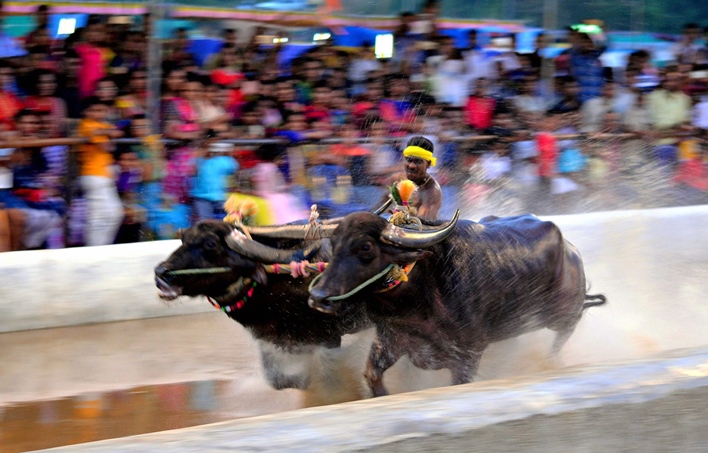
Quick Facts of Kambala
- Area: Dakshina Kannada, including Mangalore
- Highlight: Buffalo races
- Significance: Beginning of the harvesting season
- Time: November to March
History of Kambala, Karnataka
The origin of the Kambala celebration can be traced back to more than a thousand years. During the early days of the festival, it was known as Karaga celebrations. Later, they came to be known as Kambala celebrations. There are different beliefs regarding the origin of the festival.
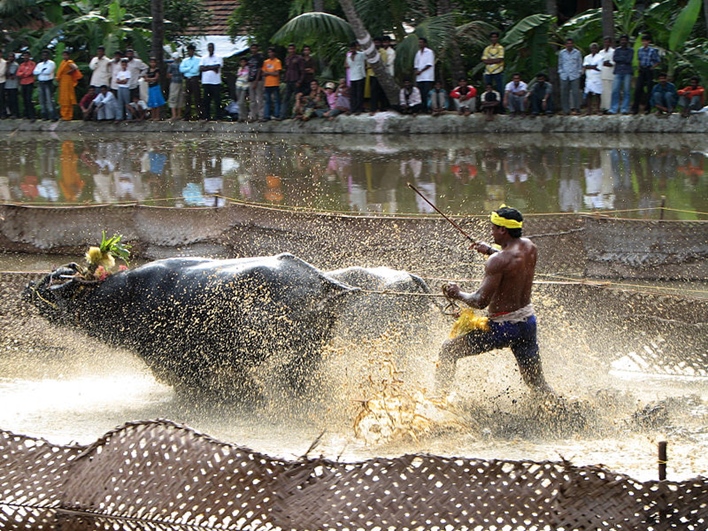
Kambala and the Farming Community
According to one belief, it is a festival that originated in the farming community of Karnataka. The festival is dedicated to Lord Kadri Manjunatha, an incarnation of Lord Shiva.
It was celebrated to please the Gods for a good harvest. It was also a form of entertainment or recreational sport for the farming community. The winner of the buffalo race was rewarded with a coconut and such other things.
Kambala – the Sport of the Royal Family
The other belief regarding the origin of Kambala is that the buffalo races originated as a sport for the royal family’s amusement or pleasure.
According to legend, the festival was started by the Hoysala Kings to see if the buffaloes could be trained and used in war. The Hoysala Kings were astonished to see the speed of the buffaloes and started racing them against one another.
As such, this developed as a sport for the royals. Later the tradition was carried on by the feudal lords of those regions and finally it was continued by the ordinary people.
The festival has managed to grow in popularity through the centuries. Today the age-old festival is organized on a large scale and a huge crowd gathers to participate in the celebrations.
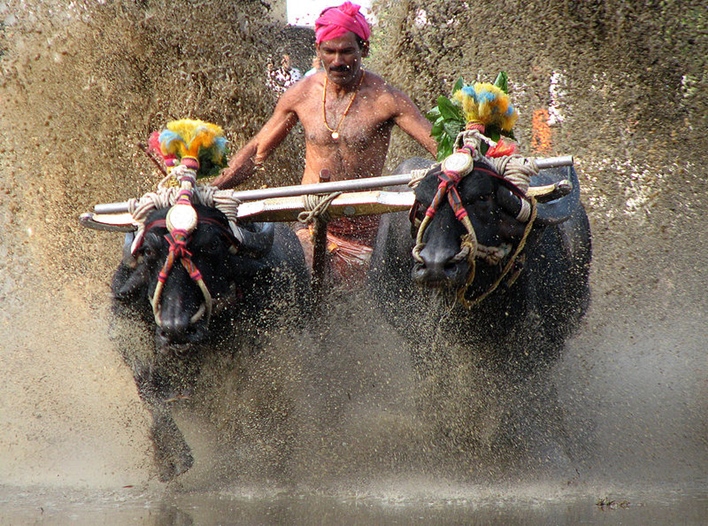
Types of Kambalas
Traditionally, there were two types of Kambalas :
- Pookere Kambala
- Bale Kambala
The celebration of Bale Kambala was discontinued about 900 years ago. So, the Kambala that we see today is the Pookere Kambala variety.
How is the Festival Celebrated?
Kambala is a simple event of buffalo races that is usually held over a two-day period. The festival begins with an inaugural ceremony and a parade of the participating farmers along with their prized buffaloes. Soon after, the much-anticipated buffalo races start.
Each team comprises of two buffaloes and a farmer who controls the buffaloes. Two teams are made to race down two slushy tracks to determine the fastest team.
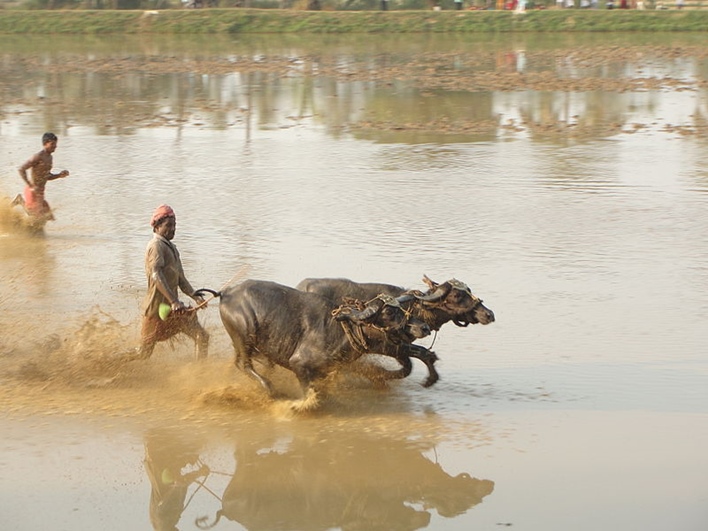
A Buffalo Race and 2 Muddy Tracks
The buffalo race is held on 2 muddy tracks that are placed parallel to each other. The racing tracks are normally about 120 to 160 metres in length and 8 to 12 metres in width, depending on the space available. The tracks are ploughed into a muddy field that is made slushy with water.
Traditionally there used to be just one track. But now 2 tracks are used for the race, though in some areas the tradition of a single track is still followed.
The Kambala – A Festival of Cheer
The festival takes place among a crowd of enthusiastic onlookers and supporters. The atmosphere becomes taut with anticipation and excitement during the races.
As each farmer frantically edges his buffaloes to race on the track and reach the finishing line at the earliest, the crowd cheers them. The farmer whose buffaloes cover the distance within the shortest time is declared the winner.
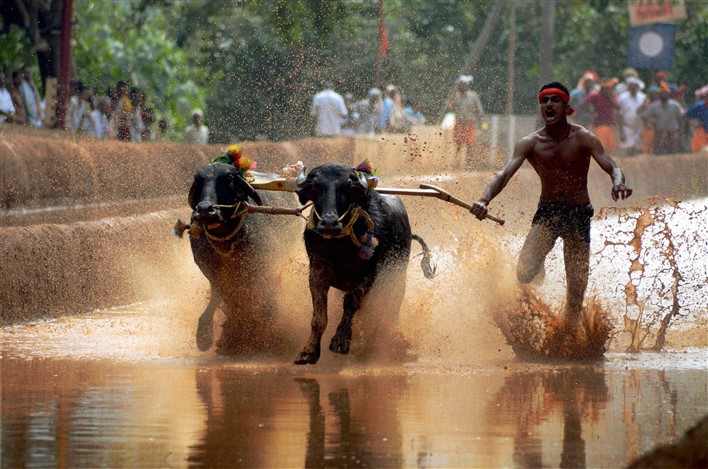
The races continue overnight. Different types of races are held at different levels that lead up to a grand finale. The grand finale is generally held in the afternoon of the second day. The swiftest pair of buffaloes is declared the winner of the race and the farmer controlling those buffaloes is awarded the prize.
Categories of Kambala Festival
The festival takes place in various categories. The four main categories are –
- Negilu
- Hagga
- Adda Halage
- Kene Halage
Negilu – In this category of the buffalo race, while racing, the farmer holds a plough that is tied to the pair of buffaloes. The thing to note is that this plough is just a representation of the actual plough used in the fields. It is a light wooden replica of the plough made especially for the race.
This category is mainly for the entry level buffaloes, which generally have no prior experience of the race. However, generally there are junior and senior rounds in this category.
Hagga – In this category of the race, the buffalo pair has a rope tied directly to them. This category involves buffaloes that are well experienced in taking part in the race.
The buffaloes of this category normally possesses more speed that the buffaloes participating under the Nigelu category. The Hagga category also has junior and senior rounds of competition.
Adda Halage – In this category of the buffalo race a wooden plank is tied to the pair of buffaloes. The farmer stands on this wooden plank while the race is in progress. This category is mainly for the senior buffaloes, which generally have prior experience of the race.
Kene Halage – In this category of the buffalo race a round-shaped wooden block is involved during the race. The farmer stands on the wooden block on a single leg. The wooden block has 2 holes through which water gushes out while running.
The height of the water gushing out through the holes is measured to determine the winner of the race. The height of the water gushing out depends on the speed of the racer – more the speed, more is the height of the water.
This category is for the most experienced farmer and the most experienced buffaloes. Generally, in the middle of the track, 2 strips of white cloth are tied across the track. These are used for height measurement of the water during the race.
If a farmer has water reaching to the markers, he is declared a winner. If more than one farmer achieves this feat, all of them who achieve this feat are declared winners of the race.
Kene Halage and Adda Halage are two categories of the buffalo race that are slowly proceeding towards discontinuation. Now-a-days there are very few participants for these two categories as compared to the other categories. As such, the threat of these categories vanishing completely from the Kambala festival scene looms large over the festival.

Kambala in Mangalore
Mangalore is one of those places where Kambala is celebrated in a big manner. The Mangalore Kambala is celebrated annually at the Kadri Kambala fields. As such, it is popularly referred to as the Kadri Kambala or Mangalore Hobali Kambala.
Kadri Kambala is also known as Devara Kambala or God’s Kambala as it is associated with the Manjunatha Temple situated in Kadri, Mangalore. Legend has it that the Kambala festival was patronised by the kings of the Alupa dynasty, who once ruled over Mangalore. For this reason, it is also known as Arasu Kambala or the king’s Kambala.
Apart from the kings, the kambala festival was also patronised by the famous households in Mangalore. It is said that in the ancient times, the buffaloes participating in the kambala festival were paraded in a procession that was accompanied by drum dancers.
Areas Where Kambala Festival is Popular
Kambala is a festival that is most popular in Mangalore and other southern coastal regions and remote villages of Karnataka. Districts such as Dakshina Kannada and Udupi celebrate this festival with much fanfare.
Every year Kambala is held in places like:
- Bajagoli
- Baradi Beedu
- Bolantur
- Kolatta
- Majalu
- Puttur
- Kamalakettu
- Uppinagadi
Present-day Celebration
The Kambala festival started has evolved into a major festival for the farmers of the coastal Karnataka region. Today the festival has turned into a popular annual event that draws people from far and near who accumulate to witness this unique show of speed and balance.
These days the buffalo races are organised professionally. The buffaloes are trained throughout the year for the event. A well-organised Kambala sees the participation of 130 to 140 pairs of buffaloes and a crowd of around 20,000 spectators. As per a report of The Times of India, more than 45 Kambalas are held annually.
About 18 Kambalas are held under a Kambala Samithi while the rest are organised under the auspices of various temples or with political patronage. The awards range from gold to cash rewards. Even tourists plan their trips during the Kambala season to witness the event.
Care for the Buffaloes of Kambala Festival
Kambala is a festival that testes the speed and swiftness of the buffaloes. As such, the buffaloes are well-fed and cared for throughout the year. Some owners of the buffaloes also build separate swimming pools for the buffaloes that compete in the races.
Even the high court has imposed certain restrictions on the organisers and the participants regarding the treatment of the buffaloes during the races. The court primarily mentioned that the buffaloes should not be subjected to cruelty and they must be well-looked after and adequately fed.
Safety Measures Taken
The Kambala festival involves high speed races of buffaloes in front of several thousand visitors. Accidents do occur sometimes while the races are in progress. As the buffaloes race ahead, sometimes they skid or topple. Even the farmer running with the buffaloes sometimes falls and gets hurt.
In this race both, the buffaloes as well as the farmer may suffer serious injuries, including fractures of the bones. As such, large Kambala organizers generally have an ambulance and veterinary doctors ready at the site of the festival for immediate control of such situations and to provide emergency medical aid.
Controversy Regarding the festival
The age-old tradition of buffalo races in Karnataka has been the cause of concern among animal lovers and animal activists for quite some time now.
The celebration of Kambala was stopped in Karnataka based on an order of Supreme Court, dated 7th May, 2014. This order was actually meant for the violent game of Jallikkatu, a bull-taming sport in Tamil Nadu. The order did not mention Kambala.
However, due to a misinterpretation of the order by the animal husbandry department, the ban was linked to Kambala as well. As such, the district administration in Karnataka was issued a directive from the animal husbandry department to ban Kambala. This order was met with much resentment by the organisers, the participants and the spectators of the popular festival.
This led the district Kambala committees to approach the high court on behalf of the Kambala committees. The high court passed an interim order on 15th December, 2014 and stayed the ban on Kambala.
The festival of Kambala is a joyful experience that must not be missed by anyone who wants to see the traditional sight of Karnataka.
Traditional Kambala Gets A Makeover
Kambala was recently in the news again as Srinivasa Gowda, one of the jockeys, ran fast enough to be compared to Olympic gold medallist Usain Bolt. Much of the news about Kambala still travels by word of mouth but there have been a few technological advances to this sport.
A Dedicated Website
To break away from relying solely on verbal records and video shot by spectators on their phones, a dedicated website is in the works for the Kambala races. The website will offer live updates and maintain records for all races. There will also be a section that records the performance of jockeys and buffaloes.
Digital Timekeeping
The finishing line and timekeeping system is being given a digital overhaul. A laser beam network system has been introduced at the starting point of the races. This complements the laser systems that were earlier introduced to the finish lines.
When the buffaloes cross over the finish line, the timing is displayed automatically on a digital screen. The laser network at both ends of the race helps the organizers get more accurate timings.
Standardized Track Lengths
Currently, races can have different lengths to complete. This will be standardized with 135m long twin track lengths.
Kambala Camp
Along with the technological innovations, other changes are also being introduced to make the races more appealing to youngsters. The Kambala Academy was established in 2011 to develop the sport and train jockeys. They conduct annual training camps for jockeys and referees.
Attendants must pass through two selection rounds including interviews and medical tests. The camp itself runs for about 2 weeks and offers training for coaches on yoga, personality development and other aspects of the race. On 2017-18, more than 150 people registered for the camps of which only 25 were selected.
Kambala is a 400-year-old tradition of racing buffaloes through paddy fields. The practice was paused for a while until the Supreme Court permitted the races to be continued in February 2018. The race typically occurs between the months of November and March. Jockeys can earn up to Rs 6 lakhs in each season.